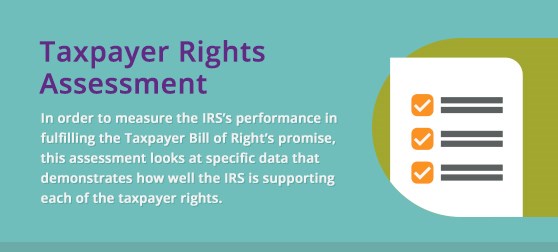Taxpayer Rights Assessment

In the 2013 Annual Report to Congress, the National Taxpayer Advocate proposed a “report card” of measures that “…provide a good indication whether the IRS is treating U.S. taxpayers well and furthering voluntary compliance.”
On June 10, 2014, the IRS adopted a Taxpayer Bill of Rights (TBOR), a list of ten rights that the National Taxpayer Advocate recommended to help taxpayers and IRS employees alike gain a better understanding of the dozens of discrete taxpayer rights scattered throughout the multi-million word Internal Revenue Code. While this was a significant achievement, more can be done. The Taxpayer Rights Assessment contains selected performance measures and data organized by the ten taxpayer rights. It takes us one step closer to integrating taxpayer rights into tax administration.
This Taxpayer Rights Assessment is a work in progress. The following data provide insights into IRS performance, but are by no means comprehensive. And, despite what the numbers may show, we must be concerned for taxpayers who still lack access to services and quality service even when performance metrics are increasing. This Taxpayer Rights Assessment will evolve as data becomes available and new concerns emerge.
SELECTED DATA
The Right to Be Informed – Taxpayers have the right to know what they need to do to comply with the tax laws. They are entitled to clear explanations of the laws and IRS procedures in all tax forms, instructions, publications, notices, and correspondence. They have the right to be informed of IRS decisions about their tax accounts and to receive clear explanations of the outcomes.
| Measure/Indicator | FY2014 |
| Individual Correspondence Volume (adjustments) | 5,700,132 |
| Average Days in Inventory | 57.6 days |
| Inventory Overage | 63.6% |
| Business Correspondence Volume (adjustments) | 3,471,571 |
| Average Days in Inventory | 39 days |
| Inventory Overage | 17.5% |
chart continues
The Right to Quality Service – Taxpayers have the right to receive prompt, courteous, and professional assistance in their dealings with the IRS, to be spoken to in a way they can easily understand, to receive clear and easily understandable communications from the IRS, and to speak to a supervisor about inadequate service.
| Measure/Indicator | FY2014 |
| Number of Returns Filed (projected, all types) | 244,429,200 |
|
Total Individual Income Tax Returns
|
147,869,100 |
| E-file Receipts (Received by 11/21/14) | 125,821,000 |
| E-file: Tax Professional | 62% |
| E-file: Self Prepared | 38% |
| Returns Prepared by: | |
| VITA / TCE / AARP | 3,322,582 |
| Free File Consortium | 2,406,465 |
| Fillable Forms | 478,501 |
| IRS Taxpayer Assistance Centers (TACs) | 376 |
| Number of Taxpayer Assistance (“Walk-In”) Centers | 382 |
| Number of TAC Contacts | 5,477,279 |
| Total Calls to IRS | 100,667,411 |
| Number of Attempted Calls to IRS Customer Service Lines | 86,171,857 |
| Toll Free: Percentage of calls answered (LOS) | 64.4% |
| Toll Free: Average Speed of Answer | 19.6 minutes |
chart continues
